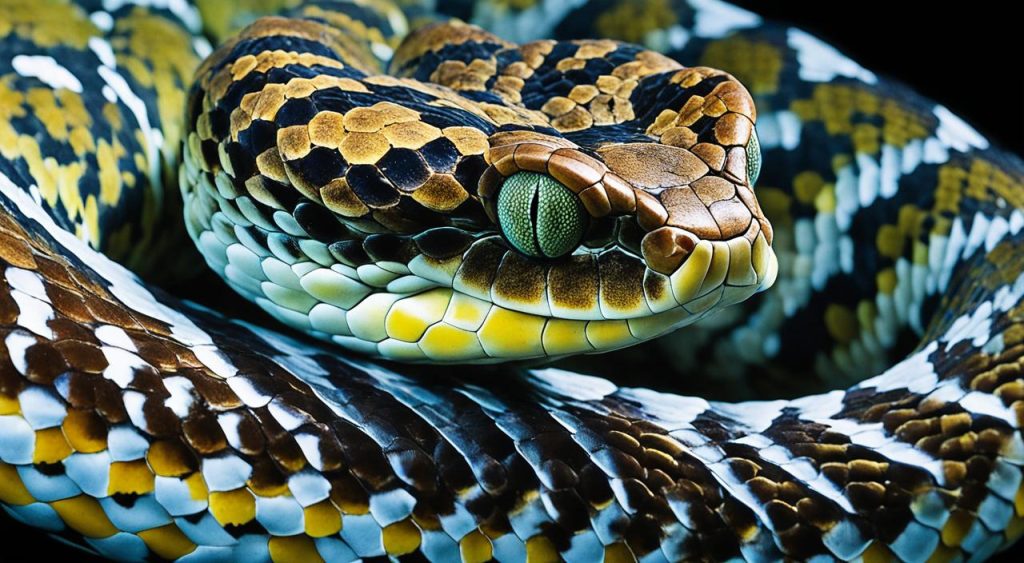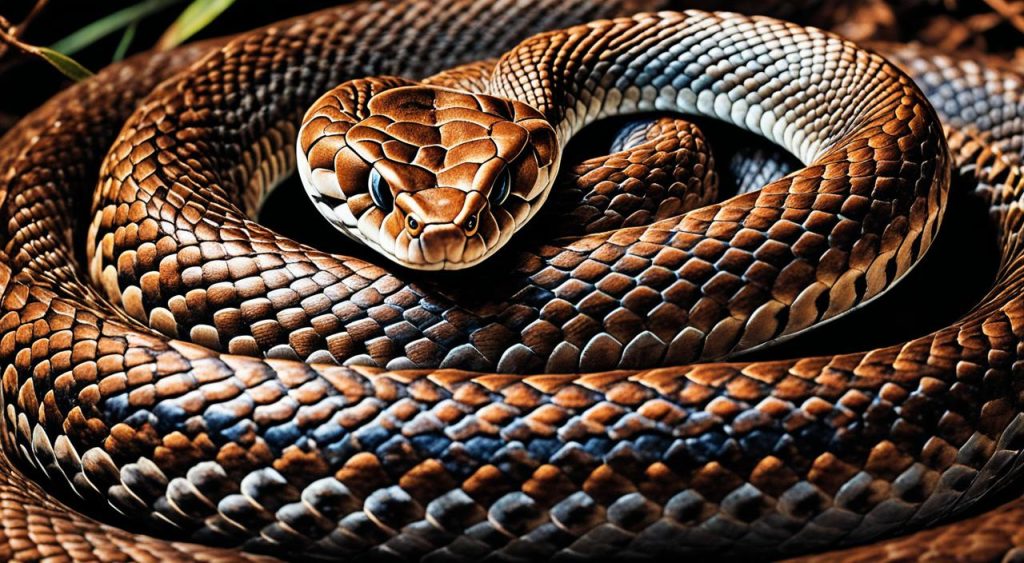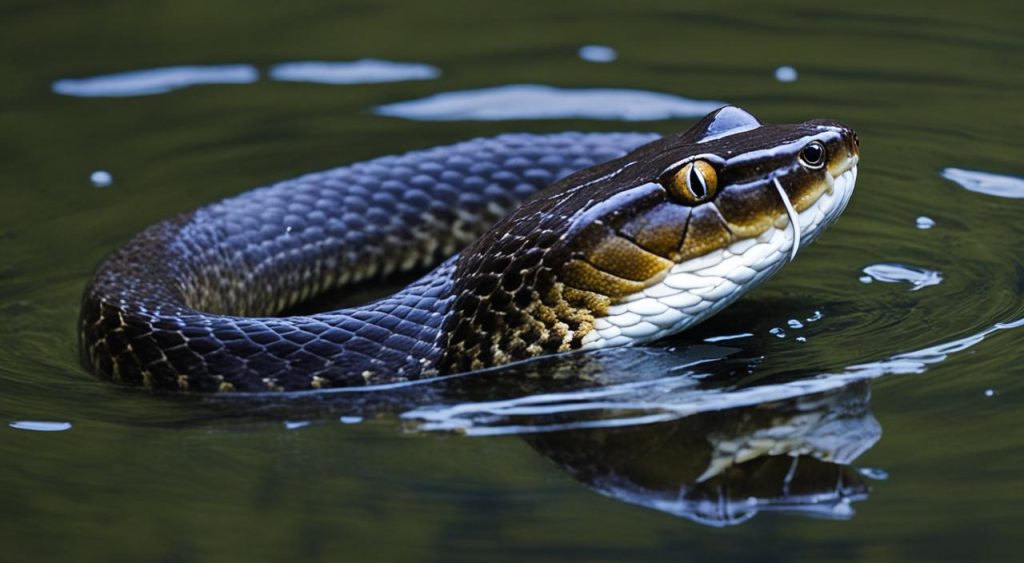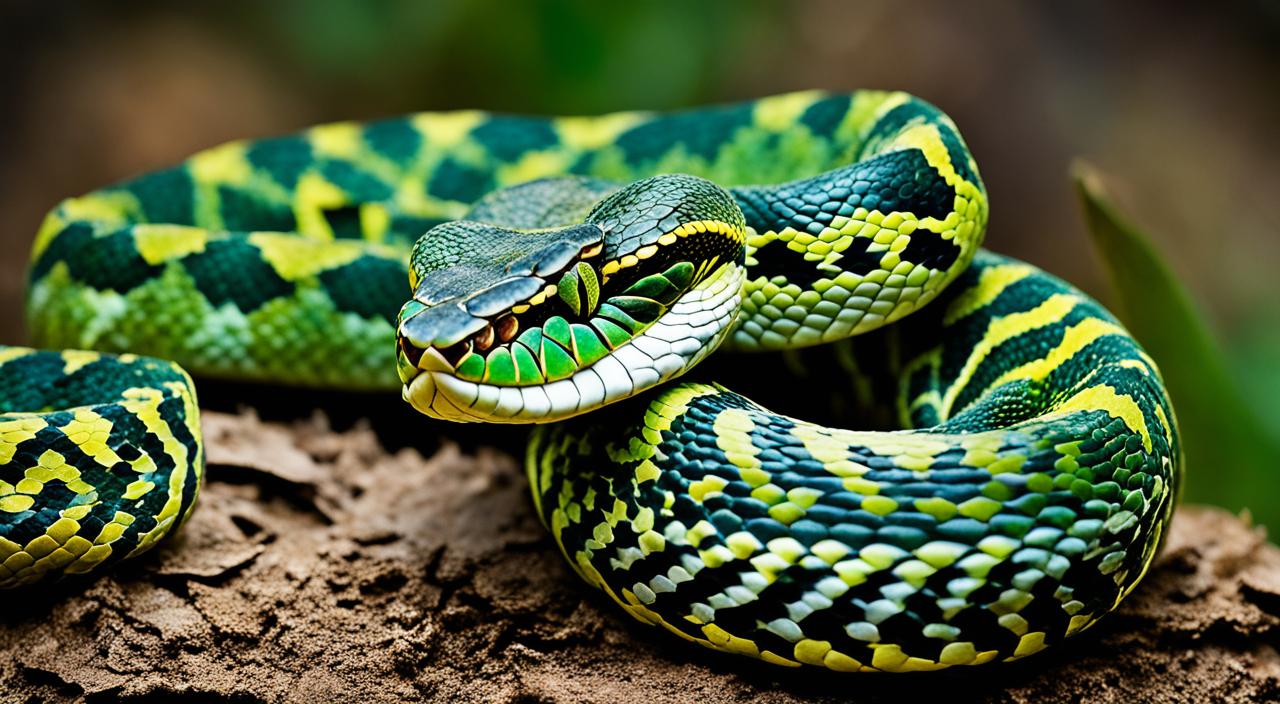The pit viper family is huge, with 151 species across 18 genera. They are found only in the Americas. These snakes are known for their special heat-sensing pits. These pits help them strike warm-blooded prey with precision.
Pit vipers include the Copperheads and Cottonmouths. They are important in their ecosystems but can be dangerous to humans. This article will explore the world of pit vipers. We’ll look at their unique traits, venom, and the different species in the Americas.
What is a Pit Viper?
Pit vipers are a subfamily of venomous snakes known for their heat-sensing pit organs. These pits are between the eyes and nostrils. They help pit vipers detect tiny temperature changes, making them better at catching prey. There are 155 recognized species of pit vipers across 23 genera. They live from southern Canada to northern Argentina.
Defining Characteristics and Identification
Pit vipers vary greatly in size, from the small hump-nosed viper to the large bushmaster. They share some key features that help identify them. These include stout bodies, keeled scales, and a triangular head shape. Many also have a thermal pit organ and a single row of scales under their body.
Unique Heat-Sensing Pit Organ
The pit organ of pit vipers is a special feature. It lets them detect heat, helping them strike warm-blooded prey in the dark. This skill makes them precise hunters.

| Pit Viper Characteristics | Description |
|---|---|
| Loreal Pits | Infrared-detecting organs that provide thermal rangefinding capabilities |
| Body Shape | Stout, with keeled scales and a distinct, triangular-shaped head |
| Size Range | From small snakes like the hump-nosed viper (30-45 cm) to the larger bushmaster (up to 3.65 m) |
| Habitat | Diverse, ranging from deserts to rainforests, with both arboreal and terrestrial species |
| Activity Pattern | Mostly nocturnal, with some exceptions being active during the day |
Pit vipers are fascinating venomous snakes with unique heat-sensing organs. They have a wide range of species. Their adaptations make them skilled at hunting, letting them strike with great precision.
Pit Viper Venom: A Deadly Cocktail
Pit viper venom is a powerful mix that can be very dangerous. It mainly targets the blood system, causing harm to tissues and blood cells. This can lead to internal hemorrhaging, organ failure, and death if not treated.
This venom stops the body from clotting blood properly. This can cause bleeding and clotting issues all over the body. Sometimes, it might be necessary to amputate affected limbs. This coagulopathy is a key sign of pit viper bites and can be very serious.
| Venom Component | Effect |
|---|---|
| Hemotoxins | Cause tissue damage and internal bleeding |
| Neurotoxins | Disrupt nerve function and can lead to respiratory failure |
| Myotoxins | Cause muscle damage and necrosis |
Pit viper venom is complex, with strong hemotoxic and tissue-damaging effects. This makes treating it hard for doctors. Quick and right medical care is key to surviving a pit viper envenomation.

The Copperhead: A Venomous Neighbor
The eastern copperhead snake is a venomous pit viper found in the eastern United States. They have unique hourglass markings and can blend into their surroundings well. Their venom is not as strong as some other pit vipers, but they cause the most snakebite incidents yearly.
Geographic Range and Habitat
The copperhead range goes from Florida’s panhandle to Massachusetts, and west to Nebraska and Texas. They live in forests, wetlands, rocky hillsides, and even suburban areas. They choose their copperhead habitat based on food and hiding spots.
Behavior and Bite Symptoms
Copperhead behavior shows they are semi-social, often living together in dens. They are most active at night in summer but hunt during the day in spring and fall. If threatened, they freeze and rely on camouflage, striking only when they must.
The copperhead bite symptoms are not as bad as other common venomous snakes. But, their tendency to freeze and strike suddenly makes them responsible for the most snakebite incidents in the U.S. The venom can cause tissue damage and should be treated by medical professionals quickly.

| Characteristic | Details |
|---|---|
| Size Range | Adult copperheads are 24″ to 36″ long, while young ones are 7″ to 10″ long. |
| Geographical Distribution | Copperheads live from Florida’s panhandle to Massachusetts, and west to Nebraska and Texas. Different subspecies live in various areas. |
| Behavior | Copperheads are semi-social snakes, often hibernating together. They are most active at night in summer but hunt during the day in spring and fall. |
| Hunting Habits | Juveniles eat insects, caterpillars, small frogs, and lizards. Adults mainly eat mice but also small birds, other snakes, and cicadas. |
| Reproduction | Female copperheads become ready to reproduce at about 3 years old. They mate in April or May, and their brood has 2 to 10 baby snakes. |
| Danger | Copperhead snake bites are the most common venomous snake bites in the U.S. Their venom is the least dangerous among pit vipers but can still be risky for humans. |
The Cottonmouth: Water’s Deadly Inhabitant
The cottonmouth, also known as the water moccasin, is a venomous snake found in the southeastern United States. It’s the only venomous water snake in North America. It lives in both water and on land, making it a threat to those who enter its territory.
This snake is bigger and more dangerous than the copperhead. It can grow up to 48 inches long and has a strong build. It has a special pit on its face that helps it find its prey, like fish and small mammals.
Cottonmouths are known for their dark colors, which can be brown or black. Young ones have faint patterns. They get their name from opening their mouths wide to show off their bright white inside when they feel threatened.

Their venom is hemotoxic, causing internal bleeding and organ failure. While not many people die from their bites, it’s still a big concern in the southeastern United States.
The cottonmouth is not considered endangered, but it’s still important to be careful around it. Since it lives near people, knowing how to stay safe is crucial.
Rattlesnakes: Icons of the American Southwest
Rattlesnakes are the iconic pit vipers of the American Southwest. They belong to the genus Crotalus, the largest pit viper group. With over 50 recognized species, these snakes show a wide range of sizes, colors, and patterns. It’s important to know how to tell them apart.
They live across the western half of the continent, from Canada to Mexico. Rattlesnakes are famous for their unique rattle and strong venom.
Species Diversity and Identification
The Crotalus genus has a wide variety of rattlesnake species. The Western diamondback rattlesnake can reach up to 7 feet long. It lives in the southwestern United States and northern Mexico.
Other notable species include the Eastern diamondback, the biggest rattlesnake. Arizona has the most rattlesnake diversity in the U.S.
Identifying rattlesnakes can be tricky because of their many colors and patterns. But, look for their distinctive rattle, triangular head, and heat-sensing pits on their face. These features help them find warm-blooded prey.
| Rattlesnake Species | Average Length | Habitat Range |
|---|---|---|
| Western Diamondback | 3-5 feet (up to 7 feet) | Southwestern U.S. and Northern Mexico |
| Eastern Diamondback | Up to 7.9 feet | Southeastern U.S. |
| Arizona Rattlesnake | 2-4 feet | Arizona, USA |
Rattlesnakes are key to the ecosystems in the American Southwest. They help keep rodent populations in check. This supports the health of the region’s diverse habitats.
“Rattlesnakes are the primary contributors to snakebite injuries in North America, but they rarely bite unless provoked. If treated promptly, the bites are seldom fatal.”
Pit Viper Reproduction and Life Cycle
Pit vipers are venomous snakes found in the Americas. They have a unique way of reproducing. Most are ovoviviparous, meaning their eggs develop inside the female’s body. The young snakes hatch fully formed and ready to live on their own.
These snakes can have a wide range of babies, from just two to over 80. The young pit vipers have brightly colored tails. They use these tails to attract prey, a behavior called caudal luring. This helps them eat as they grow.
Some pit vipers, like the bushmaster and some Asian species, are oviparous. They lay eggs instead of having live young. Bushmaster females lay 8 to 12 eggs in a burrow. These eggs take 76 to 79 days to hatch.
| Pit Viper Species | Reproductive Mode | Brood Size | Lifespan |
|---|---|---|---|
| Majority of Pit Vipers | Ovoviviparous | 2 to 86 hatchlings | 6 to 30 years |
| Bushmaster | Oviparous | 8 to 12 eggs | 12 to 24 years |
| Eyelash Pit Viper | Ovoviviparous | 2 to 20 live young | 6 to 20 years |
Learning about pit viper reproduction and life cycle helps us understand these snakes better. Their ovoviviparity and egg laying show how diverse snake reproduction can be in the Americas.
Pit Viper Habitats and Conservation
Pit vipers live in many places, from lush rainforests to dry deserts. They are found all over North, Central, and South America. Scientists have identified at least 151 different kinds of them. But, many pit viper groups are in danger, causing their numbers to go down.
Threats and Declining Populations
The main danger to pit vipers is the destruction of their homes. Cities spreading out, cutting down forests, and breaking up their living spaces are big problems. The Chocoan forest pit viper, for instance, lives in the Andes Mountains and Darien Gap swamplands. But, its home is being destroyed, putting it at risk.
Another big threat is people killing them out of fear or mistake. Some are hunted for the illegal wildlife trade. The Montane pit vipers are also facing challenges from climate change, which is changing their home.
But, there are efforts to save pit vipers and their homes. It’s important to keep and fix the places where they live. Teaching people about the role of pit vipers can also help reduce fear and protect them.
“Pit vipers are not just fascinating creatures, but also play a vital role in maintaining the balance of their ecosystems. Protecting their habitats and raising awareness about their importance is crucial for their conservation.”
Pit Viper Myths and Misconceptions
Pit vipers are often misunderstood due to myths and misconceptions. People think they can “hypnotize” their prey or that all their bites are deadly. By learning about their true nature and behaviors, we can clear up these wrong ideas. This helps us understand these amazing snakes better.
One myth is that pit vipers can “charm” or “hypnotize” their prey. But, they actually use their sharp heat-sensing pits and quick strikes to catch their food. They don’t have magical powers to control their prey.
Another myth is that all pit viper bites are deadly. While their venom is strong, thanks to antivenom and medical care, most people survive. Quick medical help is key to a full recovery.
Some think all snakes with triangular heads are venomous, or that rattlesnakes’ tail rattles show their age. But, not all snakes with triangular heads are venomous. And, rattles don’t tell how old a rattlesnake is.
By clearing up these myths, we can better understand pit vipers. These snakes are complex and interesting. They deserve respect for who they really are, not the myths that have been around for so long.
Precautions and Safety Around Pit Vipers
Pit vipers are dangerous but usually avoid humans. Still, it’s key to be careful in their territory. Know your surroundings, don’t touch the snakes, and get medical help right away if bitten.
First Aid for Pit Viper Bites
For a pit viper bite, keep the affected limb still. Don’t use tourniquets. Get the victim to a hospital fast for anti-venom. Don’t try to suck out the venom or use ice, as it can make things worse. Stay calm, call for help, and get medical care quickly.
The National Institute for Occupational Safety & Health has useful advice on handling venomous snake bites. By being cautious and keeping a safe distance from pit vipers, you can lower the risk of getting hurt or worse.
FAQ
What are the defining characteristics of pit vipers?
Pit vipers have a special heat-sensing organ on each side of their head. This organ helps them detect tiny temperature changes. This skill improves their accuracy when they strike at prey.
How many species of pit vipers are there?
There are 18 genera and 151 species of pit vipers worldwide. Many well-known species are found in North America.
What are the effects of pit viper venom?
Pit viper venom attacks the circulatory system. It causes severe damage to tissues and blood cells. This can lead to internal bleeding, organ failure, and death if not treated.
Where are copperheads found and what are their characteristics?
Copperheads are found in the eastern part of the United States. They range from New York to Texas. They are known for their unique hourglass markings and camouflage skills.
What is the cottonmouth and where is it found?
The cottonmouth, also known as the water moccasin, is a venomous water snake in North America. It lives in the southeastern United States, in both water and on land.
How diverse are rattlesnakes?
Rattlesnakes are the iconic pit vipers of the American Southwest. They belong to the genus Crotalus and have over 50 recognized species. They come in many sizes, colors, and patterns, making them hard to identify.
How do pit vipers reproduce?
Most pit viper species are ovoviviparous. This means the eggs hatch inside the female’s body, and the young snakes come out fully formed. A few species, like the bushmaster, lay eggs.
What threats do pit viper populations face?
Pit viper populations are threatened by habitat loss, pollution, and human actions. The destruction of rainforests and urban growth have reduced their numbers. Humans also hunt and kill them.
What are some common myths and misconceptions about pit vipers?
Many believe pit vipers can “hypnotize” their prey or that all their bites are deadly. These myths are not true. Learning about pit vipers helps us understand them better and correct these wrong ideas.
How should one respond if bitten by a pit viper?
If bitten, keep the affected limb still and don’t use a tourniquet. Then, get the victim to a hospital quickly for treatment with anti-venom.





2 Comments